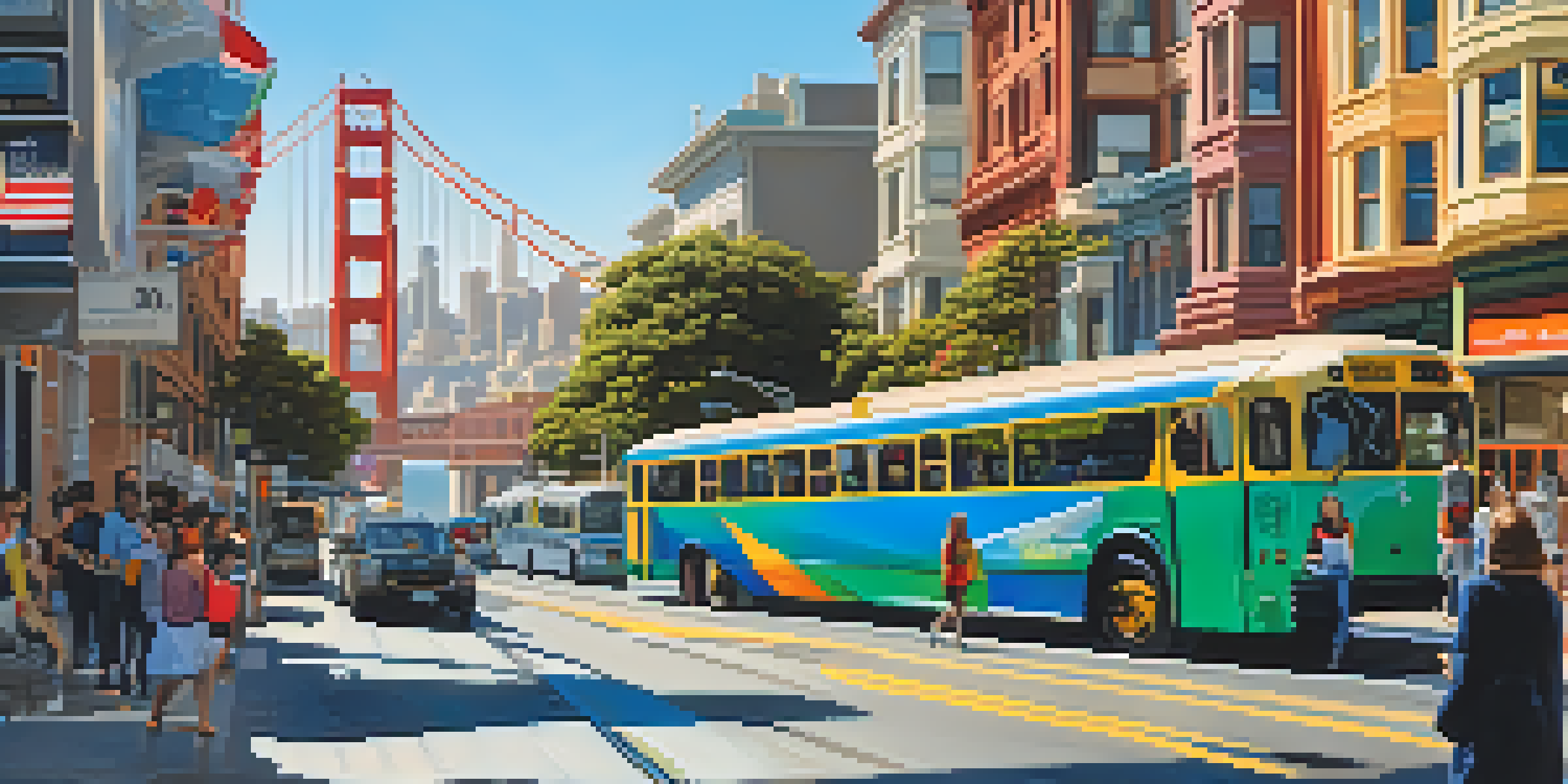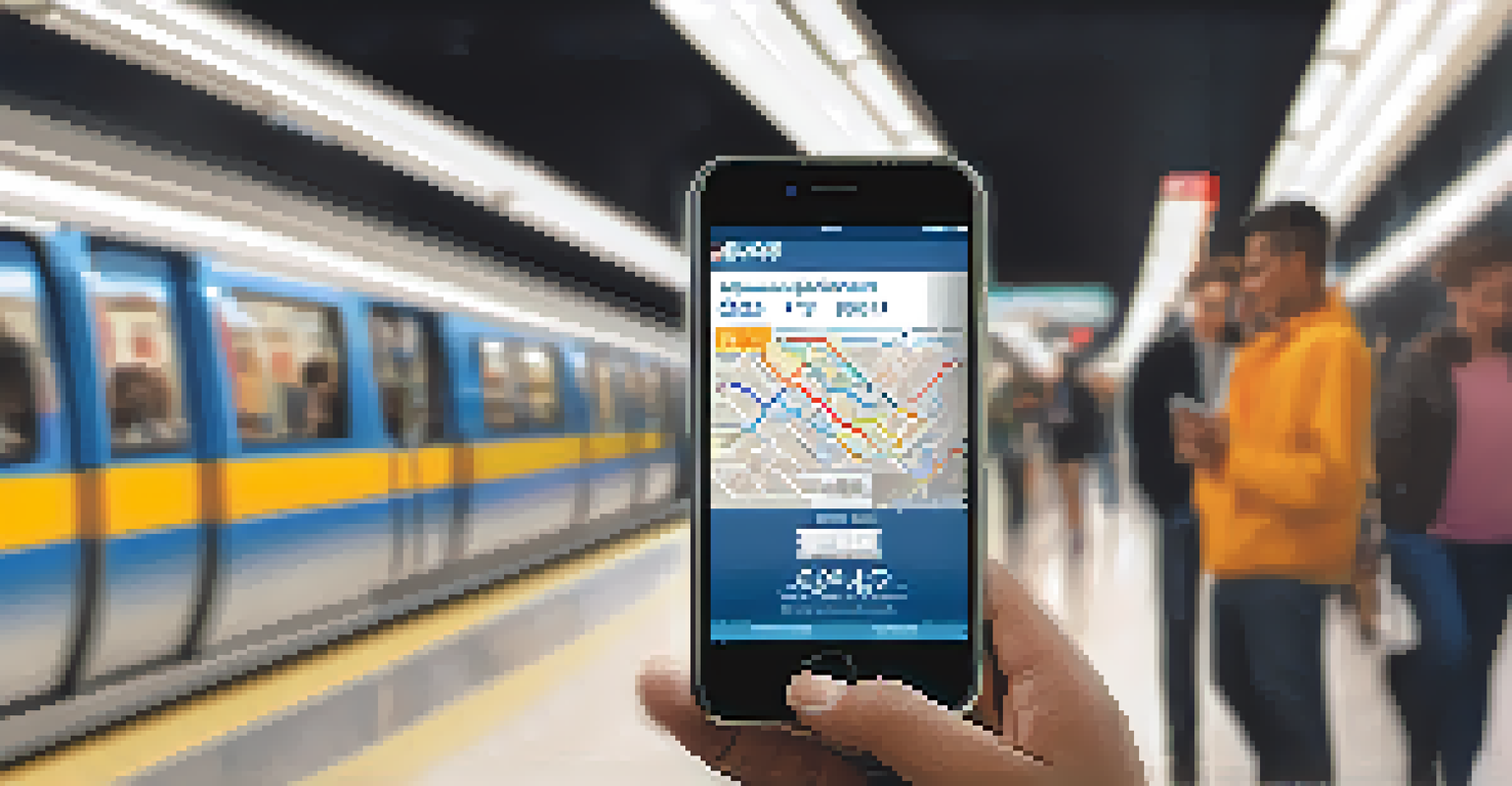The Role of Technology in San Francisco's Public Transit

The Evolution of Public Transit Technology in San Francisco
San Francisco's public transit system has undergone significant transformations over the decades, driven largely by advancements in technology. From the iconic cable cars to modern electric buses, technology has played a crucial role in enhancing the efficiency and reliability of transit services. Today, riders can enjoy real-time tracking and mobile ticketing, making the experience smoother and more user-friendly.
Public transportation is the backbone of a city’s economy and a lifeline for its residents.
The integration of technology began in earnest with the introduction of automated fare collection systems. These systems not only streamline the boarding process but also reduce wait times, allowing for a more efficient flow of commuters. As a result, public transport has become a more attractive option for those looking to navigate the city's busy streets.
Moreover, the rise of mobile applications has revolutionized how residents and tourists interact with public transit. These apps provide up-to-date information on schedules and routes, helping users plan their journeys with greater ease. This evolution signifies a shift towards a more connected and technologically adept city.
How Real-Time Tracking Enhances Commuter Experience
One of the most notable technological advancements in San Francisco's public transit system is real-time tracking. This feature allows commuters to see the exact location of their buses and trains, reducing uncertainty and anxiety about wait times. Imagine standing at a bus stop, phone in hand, knowing precisely when your ride will arrive—that's the power of real-time data.

This technology not only improves the rider experience but also aids transit agencies in managing their fleets more effectively. With access to real-time data, agencies can reroute buses during peak hours or when unexpected delays occur, ensuring that service remains consistent. This agility is vital in a bustling city where traffic conditions can change at a moment's notice.
Tech Transforms San Francisco Transit
San Francisco's public transit has evolved significantly through technological advancements like real-time tracking and mobile apps, enhancing efficiency and user experience.
Furthermore, real-time tracking helps foster a sense of community among riders. As commuters share their experiences through social media and transit apps, they contribute to a collective knowledge base that can inform others about service changes or delays. This shared information enhances the overall transit experience, making it more communal and interactive.
The Role of Mobile Apps in Modern Transit
Mobile applications have become indispensable tools for navigating San Francisco's public transit landscape. These apps not only provide real-time tracking but also offer features like route planning, fare calculation, and mobile ticket purchasing. This convenience empowers users to take control of their travel plans without the stress of traditional ticketing systems.
Technology is best when it brings people together.
Additionally, many apps include user-generated content, such as reviews or tips for navigating the system, creating an engaging platform for commuters. For instance, a rider might share a shortcut to avoid construction or recommend the best times to travel. This community-driven approach enhances the overall transit experience and fosters a sense of belonging among users.
Moreover, the integration of payment systems into these apps makes it easier than ever to travel across the city. Forgetting cash or fumbling with coins is a thing of the past—riders can now pay for fares directly from their smartphones. This seamless payment experience is a game-changer, particularly for tourists or infrequent riders who may be unfamiliar with the fare structure.
Smart Infrastructure: The Backbone of Efficient Transit
Smart infrastructure is another critical component of San Francisco's public transit modernization. This includes everything from intelligent traffic signals that prioritize public transport to advanced monitoring systems that track vehicle performance in real-time. Such technologies help minimize delays and enhance the overall reliability of transit services.
For example, smart traffic lights can adjust their timing based on the presence of buses, ensuring smoother transitions through intersections. This capability not only expedites service but also reduces congestion, benefiting all road users. It's a practical illustration of how technology can harmonize the flow of urban life.
Real-Time Tracking Reduces Uncertainty
The introduction of real-time tracking allows commuters to see bus and train locations, alleviating anxiety around wait times and improving overall satisfaction.
Moreover, the investment in smart infrastructure reflects a commitment to sustainability. By optimizing transit routes and reducing idle times, the city can lower emissions and promote greener commuting options. This focus on eco-friendly practices is essential for fostering a healthier urban environment, aligning with broader goals of sustainability.
Challenges of Implementing New Technologies
While technology offers numerous benefits, implementing new systems in public transit is not without challenges. Issues like budget constraints, staff training, and public resistance to change can hinder progress. For instance, older infrastructure may require significant upgrades to support new technologies, demanding both time and financial resources.
Additionally, there can be a learning curve for both transit workers and riders when new systems are introduced. For example, if a mobile app rolls out with features that are not user-friendly, it may lead to confusion and frustration. Ensuring that technology is accessible and intuitive is crucial for widespread adoption.
Furthermore, as technology advances, the risk of cyber threats increases. Protecting sensitive commuter data and ensuring the security of payment systems is paramount. Transit agencies must prioritize cybersecurity measures to safeguard against potential breaches, reinforcing public trust in the systems put in place.
The Impact of Social Media on Public Transit Feedback
Social media has emerged as a powerful tool for public transit agencies to connect with riders and gather feedback. Platforms like Twitter and Facebook allow commuters to voice their concerns, share experiences, and stay updated on service changes in real-time. This immediate communication channel strengthens the relationship between the transit authority and the public.
For instance, agencies can quickly address issues such as delays or service interruptions by posting timely updates on their social media accounts. This proactive approach not only keeps riders informed but also demonstrates transparency, which can enhance public confidence in the system. A simple tweet can go a long way in alleviating commuter frustrations.
Community Engagement via Social Media
Social media serves as a vital platform for public transit agencies to engage with riders, gather feedback, and foster transparency in service updates.
Moreover, social media serves as a platform for advocacy and community engagement. Riders can rally support for improvements or new initiatives, creating a sense of collective power. By harnessing the voices of the community, transit agencies can better understand the needs and desires of their users, shaping services that truly cater to their audience.
Future Innovations: What Lies Ahead for Public Transit
Looking ahead, the future of public transit in San Francisco is poised for further innovation. With trends like autonomous vehicles and electric transit options on the horizon, the potential for transformation is exciting. These advancements could lead to even more efficient, eco-friendly, and accessible public transport solutions.
Moreover, the integration of artificial intelligence (AI) in traffic management systems could optimize routes based on real-time data analysis. Imagine a scenario where buses adapt their schedules dynamically based on actual demand, reducing wait times and improving service frequency. This level of responsiveness could revolutionize urban mobility.

As technology continues to evolve, community involvement will remain critical. Engaging riders in the decision-making process and soliciting feedback on new technologies will be essential for successful implementation. The future of public transit in San Francisco will not only be shaped by innovation but also by the voices of those who rely on it daily.